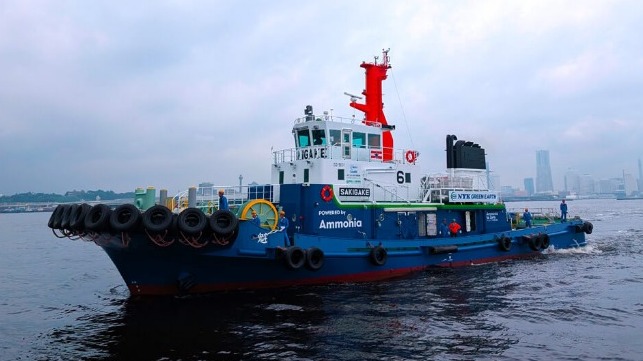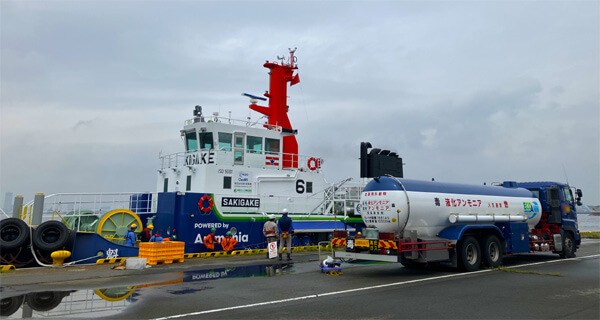NYK Bunkers Ammonia-Fueled Tug to Prepare for Sea Trials

Japan’s NYK Group reports it has taken another key step as it prepares to start sea trials for the first ammonia-fueled harbor tug. After years of planning, design, and permitting, the conversion project began to outfit the first tug boat to operate on ammonia as its primary fuel.
Bunkering of the Sakigake, which is also being called A-Tug, took place yesterday, July 17 in Yokohama, Japan. The bunkering was completed using the truck-to-ship method, marking the first time the tug has been fueled with ammonia and followed two similar bunkering operations earlier this year in Singapore for Fortescue’s converted OSV which became the first large ship to be bunkered with ammonia as part of testing and certification by the Singapore authorities.
NYK reports that the tug was fueled with a unique form of ammonia called Ecoann which is produced by Resonac Corporation at the company's Kawasaki plant. Resonac explains unlike the traditional process for producing ammonia from naphtha or natural gas, it uses a process that partially employs recycled plastics as one of the fuel’s raw materials. The process reduces CO2 emissions during production by around 35 percent.
The ammonia bunkering was conducted at the Honmoku Wharf of the port of Yokohama under a fuel-supply agreement that NYK concluded with JERA. The Ecoann will be used for the sea trials of the A-Tug. JERA will also be responsible for the future supply of ammonia to the vessel.

Ammonia bunkering took place in Japan in a truck-to-ship operation (NYK)
The conversion project began in October 2023 at the Oppama facility of Keihin Dock Company using the Sakigake, a tug that was built in 2015 as the first LNG-fueled tug in Japan. It had a dual-fuel engine manufactured by Niigata Power Systems capable of using LNG and heavy fuel. During eight years of operation, the tug was bunkered 183 times also using a truck-to-ship supply of LNG.
During the conversion, they cut into the engine room to remove the existing main engine and fuel tank. The tug was fitted with a new engine developed in a project with NYK, Japan Engine Corporation, IHI Power Systems, and Nihon Shipyard. NYK reports the engine was tested at IHI’s Ita Plant to confirm virtually zero emissions from the unburned ammonia and nitrous oxide (N2O).
The conversion project for A-Tug is due to be completed in August. The vessel will continue to be operated by NYK’s Shin-Nihon Kaiyosha. The goal is to verify its decarbonization effect and operational safety as a pioneer for ammonia-fueled vessels.
In the U.S., ammonia-to-power startup company Amogy is also working to complete the conversion of a tug to demonstrate its ammonia power technology. They announced last year the plan to convert a 1957-vintage tug which has been renamed NH3 Kraken. The work is reported to be underway at the Feeney Shipyard in Kingston, New York with the company saying testing will begin in the near future.
Electric-powered tugs using batteries have been introduced in several efforts to decarbonize the industry. The Port of Antwerp also launched two demonstration projects, first a methanol-fueled tug and recently the first hydrogen-fueled tug.
No comments:
Post a Comment